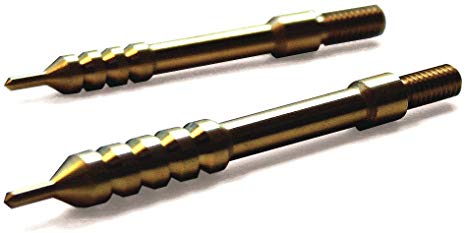
The jag itself is rather simple, an attachment that is found at the end of a cleaning rod. They tend to be sharp and pointed to do their work.
The primary purpose of a jag is to hold the cleaning patch in place as it moves up and down the gun barrel. There are different sizes of jags that can be used with cleaning rods, which means that you will need to find the right one for the job.
Jags come with sizes printed on them, so be sure to check the size before making the purchase. They come in two versions, slotted and non-slotted.
The non-slotted type pushes the patch for cleaning while the slotting type works when you pull the patch. Most people prefer non-slotted patches as pushing does not redistribute the fouling which may alter the trajectory of the bullet.
Just be sure not to mix up similarly sized jags as they can be difficult to tell apart unless they are stamped.
What Are Gun Cleaning Jags Used For?
The best use of a proper jag is to make cleaning a barrel more efficient.
Because the patch will fit securely on the jag, the barrel can be cleaned of the grime, dirt, and debris that is building up in the bore.
The jag will move the patch into the hard-to-reach areas of the barrel to scour out the breech and the rifling for a clean result.
1- Protection:
Because the patch remains secure on the jag, it protects the inside of the barrel or the bore. This is because there is no contact between the metal of the bore and the cleaning rod itself. This does require a properly sized patch for this to work.
2- Inspection:
The most practical way to inspect a new barrel for any defects inside is to run a cleaning patch through it using a jag.
Any loose or tight spots in the barrel will be noticed quickly when you run the jag up and down the inside of the barrel. Any small imperfections can be smoothed out before you fire the weapon.
3- Unblocking:
If you should lose the patch inside the barrel, a jag is a simple way to get it out. You can grab and pull the patch out using the jag without damaging the inside of your barrel.
4- Lubrication:
Once the barrel is cleaned, you can then lubricate the inside to prevent it from rusting. A little oil on the patch will provide plenty of lubrication without fouling up the barrel. The trick is to reach these areas without wearing down the inside of the barrel.
Be sure to use good quality alloy jags along with a proper cleaning kit. The good quality ones will last far longer compared to plastic versions and serve you well for years to come.
How to Use A Jag To Clean A Gun Correctly?
You start with a brass jag designed to fit the caliber of the barrel. The jag itself will be shaped much like a plunger and the pointed tip will hold the cleaning patch in place.
The tight fit of the right sized patch and jag will mean proper cleaning of the bore. The pressure that you apply will remove any excess oil, solvent, and fouling that might be present inside the barrel.
You will need a proper cleaning kit, jag, solvent, and oil for your cleaning efforts. You’ll want to unload the firearm to avoid any accidents. Be sure to check twice to ensure that it is unloaded before you start the cleaning process.
Open up the action or remove the bolt so you can start cleaning. You’ll want to clean the firearm from the breech if possible, to avoid any damage to the muzzle of the weapon.
- Attach the proper size jag to the cleaning rod
- Place the patch and add plenty of cleaning solvent
- Run the patch down the barrel and remove it when it passes through the muzzle.
At this point, let the solvent sit inside the barrel for several minutes. This will loosen any fouling, dirt, and debris that may be inside.
- Replace the jag with a brush that has solvent on it and then run it down the barrel several times
- Once the fouling is removed, put the jag and new patch on with solvent and run down the barrel
- Remove patch once it exits the muzzle
- Repeat until the patches are clean
Once the patches are clean, you can run some dry patches down the barrel in the same fashion to remove the excess solvent.
Then inspect the barrel for any obstructions and then lubricate a single patch with oil to run down the barrel once. This will protect the inside with a thin layer of oil to prevent rusting.
